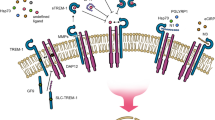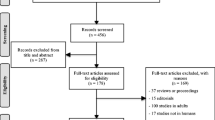Summary
The serum levels of soluble TNF receptors I (sTNFR I) and sTNFR II were measured frequently in 14 patients with sepsis to evaluate the pattern of these TNF antagonists in relation to TNF alpha, Soluble TNFR I and II could be detected in all samples with significantly higher levels (p<0.001) compared to healthy controls. The concentration of sTNFR I as well as sTNFR II was significantly higher in nonsurvivors compared to survivors during the first 36 h of sepsis (p<0.001). Levels remained elevated throughout the evaluation with maximal values in patients who died. A positive correlation exists between both receptors and between soluble receptors and simultaneously obtained sepsis score (p<0.01) while TNF immunoreactivity detected in 80% of all samples did not correlate to soluble receptor levels or sepsis score. Soluble receptors were constantly found in the circulation representing the inflammatory state throughout the evaluation even when TNF activity was undetectable.
Zusammenfassung
Die Serumspiegel der löslichen TNF-Rezeptoren I (sTNFR I) und II (sTNFR II) wurden in kurzen Zeitabständen bei 14 Patienten mit der Diagnose einer Sepsis bestimmt, um die Kinetik der natürlich vorkommenden TNF-Antagonisten in Relation zu TNF alpha zu untersuchen. Die sTNFR I und II waren signifikant gegenüber gesunden Kontrollprobanden erhöht (p<0,001). Die Serumkonzentrationen sowohl des sTNFR I als auch des sTNFR II waren während der ersten 36 Stunden der Sepsis bei den Patienten, die verstarben, signifikant höher als bei den Überlebenden (p<0,001). Die Konzentrationen blieben während der weiteren Messungen erhöht und zeigten maximale Werte bei Patienten mit einem letalen Ausgang. Eine positive Korrelation bestand zwischen den beiden löslichen Rezeptoren sowie den Rezeptoren und dem gleichzeitig bestimmten Sepsis Score (p<0,01), während die Immunreaktivität von TNF alpha, die in 80% aller Proben gemessen wurde, keine positive Korrelation zu den löslichen TNF-Rezeptoren oder dem Sepsis Score aufwies. Die löslichen TNF-Rezeptoren I und II können während der Sepsis zu jedem Zeitpunkt und auch dann nachgewiesen werden, wenn keine meßbare TNF-Aktivität vorliegt.
Similar content being viewed by others
References
Vassali, P. The pathophysiology of tumor necrosis factor. Ann. Rev. Immunol. 10 (1992) 411–452.
Deitch, E. A. Multiple organ failure. Ann. Surg. 216 (1992) 117–134.
Waage, A., Halstensen, A., Espevik, T. Association between tumor necrosis factor in serum and fatal outcome in patients with meningococcal disease. Lancet i (1987) 355–357.
Lowry, S. E. Cytokine mediators of immunity and inflammation. Arch. Surg. 128 (1993) 1235–1241.
Gehr, G., Gentz, R., Brockhaus, M., Loetscher, H., Lesslauer, W. Both tumor necrosis factor receptor types mediate proliferative signals in human mononuclear cell activation. J. Immunol. 149 (1992) 911–917.
Ware, C. F., Crowe, P. D., Vanarsdale, T. L., Andrews, J. L., Grayson, M. H., Jerzy, R., Smith, C. A., Goodwin, R. G. Tumor necrosis factor (TNF) receptor expression in T-lymphocytes. Differential regulation of the type I TNF receptor during activation of resting and effector T cells. J. Immunol. 147 (1991) 4229–4238.
Tartaglia, L. A., Weber, R. F., Figsri, I. S., Reynolds, C., Palladino, M. A., Goedell, D. V. The two different receptors for tumor necrosis factor mediate distinct cellular responses. Proc. Natl. Acad. Sci. (USA) 88 (1991) 9292–9296.
Tsujimoto, M., Vilcek, J. Tumor necrosis factor receptors in HeLa cells and their regulation by interferon gamma. J. Biol. Chem. 261 (1986) 5384–5388.
Kohno, T., Brewer, M. T., Baker, S. L., Schwartz, P. E., King, M. W., Hale, K. K., Squires, C. H., Thompson, R. C., Vannice, J. L. A second tumor necrosis factor receptor gene product can shed a naturally occurring tumor necrosis factor inhibitor. Proc. Natl. Acad. Sci. (USA) 87 (1990) 8331–8335.
Loetscher, H., Pan, Y.-C. E., Lahm, H. W., Gentz, R., Brockhaus, M., Tabuchi, H., Lesslauer, W. Molecular cloning and expression of the human 55 kD tumor necrosis factor receptor. Cell 61 (1990) 351–359.
Smith, C. A., Davies, T., Anderson, D., Solam, L., Beckmann, M. P., Jerzy, R., Dower, S. K., Cosman, D., Goodwin, R. G. A receptor for tumor necrosis factor defines an unusual family of cellular and viral proteins. Science 248 (1990) 1019–1023.
Froon, A. H., Bemelmanns, M. H., Greve, J. W., van der Linden, C. J., Buurman, W. A. Increased plasma concentrations of soluble tumor necrosis factor receptors in sepsis syndrome: correlation with plasma creatinine values. Crit. Care Med. 22 (1994) 803–809.
Rogy, M. A., Coyle, S. M., Oldenburg, H. S. A., Rock, C. S., Barie, P. S., Van Zee, K. J., Smith, C. G., Moldawer, L. L., Lowry, S. F. Persistently elevated soluble tumor necrosis factor receptor and interleukin-1 receptor antagonist levels in critically ill patients. J. Am. Coll. Surg. 178 (1994) 132–138.
Girardin, E., Roux-Lombard, P., Grau, G. E., Suter, P., Gallati, H., Dayer, J.-M. Imbalance between tumor necrosis factor-alpha and soluble TNF receptor concentrations in severe meningococcaemia. Immunology 76 (1992) 20–23.
Van Zee, K. J., Kohno, T., Fischer, E., Rock, C. S., Moldawer, L. L., Lowry, S. F. TNF soluble receptors protect against excessive TNF alpha during infection and injury. Proc. Natl. Acad. Sci. (USA) 89 (1992) 4845–4849.
Adolf, G. R., Fruhbeis, B. Monoclonal antibodies to soluble human TNF receptor (TNF binding protein) enhance its ability to block TNF toxicity. Cytokine 4 (1992) 180–184.
Bone, R. C., Sprung, C. L., Sibbald, W. J. Definitions for sepsis and organ failure. Crit. Care Med. 20 (1992) 724–726.
Elebute, E. A., Stoner, H. B. The grading of sepsis. Br. J. Surg. 70 (1983) 29–31.
Zabel, P., Schönharting, M. M., Wolter, D. T., Schade, U. F. Oxpentifylline in endotoxaemia. Lancet 334 (1989) 1474–1477.
Michie, H. R., Manogue, K. R., Spriggs, D. R., Revhaug, A., O'Dwyer, S., Dinarello, C. A., Cerami, A., Wolff, S. M., Wilmore, D. W. Detection of circulating tumor necrosis factor after endotoxin administration. N. Engl. J. Med. 318 (1988) 1481–1486.
Tracy, K. J., Lowry, S. F., Fahey, T. J. 3rd, Albert, J. D., Fong, Y., Hesse, D., Beutler, B., Manogue, K. R., Calvano, S., Wei, H., Cerami, A., Shires, G. T. Cachectin/tumor necrosis factor induces lethal shock and stress hormone responses in the dog. Surg. Gynecol. Obstet. 164 (1987) 415–422.
Tracy, K. J., Fong, Y., Hesse, D., Manogue, K. R., Lee, A. T., Kuo, G., Lowry, S. F., Cerami, A. Anti-cachectin/TNF monoclonal antibodies prevent septic shock during lethal bacteremia. Nature 330 (1987) 662–664.
Ertel, W., Morrison, M. H., Wang, P., Zheng, F., Ayala, A., Chaudry, I. H. The complex pattern of cytokines in sepsis. Association between prostaglandins, cachectin and interleukins. Ann. Surg. 214 (1991) 141–148.
Tracy, K. J. Tumor necrosis factor (cachectin) in the biology of septic shock syndrome. Circ. Shock 35 (1991) 123–128.
Fong, Y., Moldawer, L. L., Shires, G. T., Lowry, F. The biological characteristics of cytokines and their implications in surgical injury. Surg. Gynecol. Obstet. 170 (1990) 363–378.
Engelberts, I., Stephens, S., Francot, G. J. M., Van der Linden, C. J., Buurman, W. A. Evidence for different effects of soluble TNF-receptors on various TNF measurements in human biological fluids. Lancet 338 (1991) 515–516.
Nophar, Y., Kemper, O., Brakebusch, C., Engelmann, H., Zwang, R., Aderka, D., Holtmann, H., Wallach, D. Soluble forms of tumor necrosis factor receptors (TNF-R's). The cDNA for the type I TNFR cloned using amino acid data of its soluble form, encodes for both the cell surface and a soluble form of the receptor. EMBO J. 9 (1990) 3269–3278.
Thompson, W. A., Coyle, S., Van Zee, K., Oldenburg, H., Trousdale, R., Rogy, M., Felsen, D., Moldawer, L., Lowry, S. F. The metabolic effects of platelet-activating factor antagonism in endotoxemic man. Arch. Surg. 129 (1994) 72–79.
Lesslauer, W., Tabuchi, H., Gentz, R., Brockhaus, M., Schlaeger, E. J., Grau, G., Piguet, P. F., Pointaire, P., Vassalli, P., Loetscher, H. Recombinant soluble tumor necrosis factor receptor proteins protect mice from lipopolysaccharide-induced lethality. Eur. J. Immunol. 21 (1991) 2883–2886.
Ashkenazi, A., Marsters, S. A., Capon, D. J., Chamow, S. M., Figari, I. S., Pennica, D., Goeddel, D. V., Palladino, M. A., Smith, D. H. Protection against endotoxic shock by a tumor necrosis factor receptor immunoadhesin. Proc. Natl. Acad. Sci. (USA) 88 (1991) 10535–10539.
Wong, G. H., Tartaglia, L. A., Lee, M. S., Goeddel, D. V. Antiviral activity of tumor necrosis factor is signaled through the 55 kDa receptor, type I TNF. J. Immunol. 149 (1992) 3350–3353.
Pfeffer, K., Matsuyama, T., Kündig, T. M., Wakeham, A., Kishihara, K., Shahinian, A., Wiegmann, K., Ohashi, P. S., Krönke, M., Mak, T. W. Mice deficient for the 55 kd tumor necrosis factor receptor are resistant to endotoxic shock, yet succumb toL. monocytogenes infection. Cell 73 (1993) 457–467.
Author information
Authors and Affiliations
Rights and permissions
About this article
Cite this article
Schröder, J., Kremer, B., Stüber, F. et al. Pattern of soluble TNF receptors I and II in sepsis. Infection 23, 143–148 (1995). https://doi.org/10.1007/BF01793854
Received:
Accepted:
Issue Date:
DOI: https://doi.org/10.1007/BF01793854




